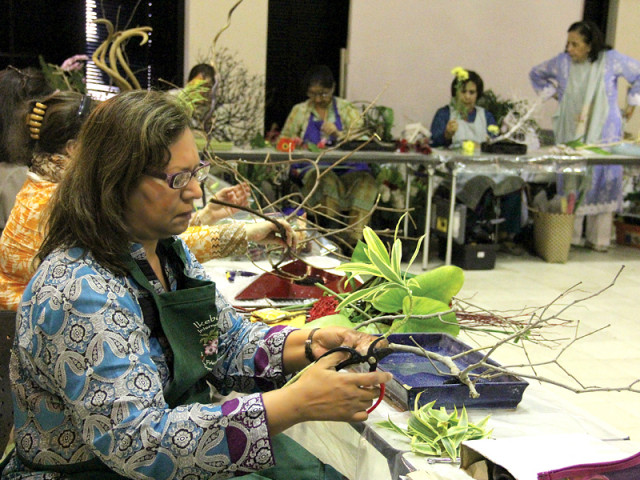Friendship through flowers: ‘Turn a new leaf to the rhythm of Ikebana’
The ancient art of Japanese floral arrangement aims to promote peace and harmony to the artist and viewers.

Students at the workshop arrange the stems and leaves of the plant according to the guidelines of Ikebana. PHOTO: AYESHA MIR/ EXPRESS
For the residents of the city, who are perpetually on panic mode, the Ikebana workshop on Monday was definitely a stress reliever.
The Japanese art of floral arrangement, Ikebana, is a disciplined art form through which nature and humanity are brought together. Although referred to as floral arrangement, Ikebana emphasises more on the stems and leaves rather than the flowers. With stringent rules governing all aspects of the art, it is vital for the artist to adhere to the guidelines and take a minimalistic approach to ensure a successful end product, said Ikebana expert Christopher Lim.
He was conducting a workshop on the art for about 40 students at the Japanese Consulate on Monday. The workshop was organised by the Japan Consul, in association with the Ikebana International, Karachi Chapter.
The students, all women above the age of 40, were simply awestruck as they watched the maestro at work - using techniques, such as twisting and bending to arrange the plant according to his style.
The workshop was divided into four sessions - each session was designed to train the students regarding a different sub-category of the art. Lim, while conducting the workshop, asked the students to make a finished product on their own while he made one for the class to see. He then walked around the room to inspect the specimen prepared by the students and assess their techniques. “Lots of mistakes,” he remarked at one of the pieces. When he saw the startled expression of the student, however, he was quick to explain that his criticism was not meant to embarrass anyone - rather, he wanted the students to learn new techniques so they may be able to produce better products on their own. “It took me 32 years to attain the expertise I have today. We learn from our mistakes - you will learn from yours and hopefully able to become an expert yourself someday,” he smiled.
Lim explained that the arrangement of the flowers could be related to the way humans interacted and conducted themselves. “In the Japanese culture, it is rude to address someone with your back towards them, thus the rule states that a leaf must not have its back towards the viewer. Similarly, the Japanese bow in salutation as a mark of respect when they greet each other. Hence, the stems must be slightly bent at an angle.”
Lim advised the students to seek inner peace and relax their minds before they attempted the floral arrangement. The sombre music playing in the background was an attempt to soothe the students’ minds and allow them to think peacefully, he explained. “Do you like the music I brought today ladies?” he asked. The music was instrumental - slow and soothing. “I brought this so you can feel calm and relaxed while making your arrangements, away from your husbands and daily life,” he hinted sheepishly.
Explaining the history of the art form and its significance in the Japanese culture, Lim said that, “The Japanese art of floral arrangement reflects Japanese aesthetics. It dates back to the end of the 15th century and is now appreciated around the world.”
The consul-general of Japan, Akira Ouchi, said that, “It is our wish to promote the message of harmony and peace through cultural events such as this one.” The ancient art of Ikebana promotes the message of peace and has a significant place in Japanese culture, he added.
Praising the four Ikebana groups operational in the city, Ouchi pledged support to the Japanese Culture Organisation for all such events that attempted to promote mutual harmony among the two countries.
Published in The Express Tribune, September 10th, 2013.



















COMMENTS
Comments are moderated and generally will be posted if they are on-topic and not abusive.
For more information, please see our Comments FAQ